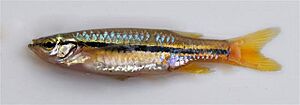Indian flying barb facts for kids
Quick facts for kids Indian flying barb |
|
|---|---|
 |
|
| Conservation status | |
| Scientific classification | |
| Genus: |
Esomus
|
| Species: |
danrica
|
| Synonyms | |
|
|
The Indian flying barb (Esomus danrica) is a cool type of fish known for its super long whiskers, called barbels. It was first discovered way back in 1822 by a scientist named Hamilton. Even though it's a neat fish, you don't often see it in home aquariums. You can find these fish living in countries like Myanmar, Nepal, Pakistan, Sri Lanka, and India. They often share their homes with other popular fish like the zebra danio.
What Does the Indian Flying Barb Look Like?
The Indian flying barb can grow up to about 6 inches (15 centimeters) long. It's a shiny silver fish with a dark line running along its long body. Its fins often have a pretty gold color. The special whiskers, or barbels, on its face are very long. They can reach almost to its back fin!
Amazing Behavior: Why is it Called a "Flying" Barb?
This fish has an amazing ability to jump! That's why it's called a "flying" barb. Because of this, if you ever keep one, you'd need a tank with a very tight lid. This stops them from jumping out and exploring your room!
Caring for Your Indian Flying Barb
If you're thinking about keeping an Indian flying barb, here are some things to know about its habitat:
- Water Temperature: They like water that is between 68 and 77 degrees Fahrenheit (20-25 Celsius).
- Water pH: The water should be slightly alkaline, around 7.6 pH.
- Water Hardness: They prefer soft to medium hard water.
- Salt in Water: They need fresh water with no salt.
- Tank Mates: They get along well with most other fish. However, like many danios, they are fast swimmers. They need plenty of space to swim around.
- Lifespan: These fish typically live for 3 to 5 years.
- How Easy to Keep: They are moderately easy to care for.
- How Easy to Breed: Breeding them can be moderate to hard.


